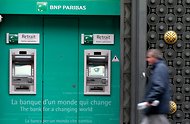A big problem with the euro zone’s one-size-fits-all monetary policy is that it risks fitting nobody. That, indeed, was a central cause of the crisis.
Early in the century, countries like Spain and Ireland were booming, while Germany was in the doldrums. Setting interest rates at a level that worked well for the euro zone on average had the effect of inflating the Spanish and Irish property bubbles while pushing wages up, so their economies became uncompetitive. When the bubbles burst, the damage was devastating.
It would be hard to argue that any part of the euro zone is currently booming. Even Germany will eke out growth of only 0.3 percent this year, according to the International Monetary Fund. But it may not be long before the problems of a one-size-fits-all monetary policy are back to haunt the zone. Even though the German economy is not growing strongly, it is still outperforming the average. What is more, labor is in short supply and house prices are rising at a moderate clip — a big contrast to the average among euro zone states, let alone recession-troubled countries such as Italy.
The European Central Bank’s policy of keeping interest rates at the current level of 0.5 percent or lower for an “extended period” is right for the euro zone on average. The weaker countries would benefit from even looser monetary policy. Germany, though, may already need something tighter. If the “extended period” of low interest rates goes on for years, it could experience a boom.
Many observers view one-size-fits-all interest rates as one of the zone’s design defects, about which nothing can be done. Others advocate policies — like full fiscal union — that are not going to be adopted and would not really hit the spot, even if they were. But the outlook is not quite so pessimistic. There are two policies that could considerably mitigate the damage of the common monetary policy — and they do not even require any treaty changes.
The first is for euro zone members to pursue vigorous “macroprudential” policies. Since Lehman Brothers went bust five years ago, it has become fashionable to call for bank regulators to have the tools to prevent future bubbles. The main idea is that they should be able to stop credit and asset prices from growing too fast by directly intervening in the way banks lend. One way of doing that would be to increase the minimum capital buffers banks have to hold if the economy is overheating; another would be to cut the size of mortgages they are allowed to make.
Such macroprudential policies are a good idea everywhere. But they are particularly important for the euro zone because individual countries cannot use interest rates or exchange rates to stop overheating. Using macroprudential policy would not just restrain future booms; it would mean that a country’s banking system would be better placed to weather the subsequent bust.
The European Union is gradually putting the necessary building blocks in place. One element of that effort is giving the regulatory authorities the job of conducting macroprudential policy. Ten of the 28 E.U. members, including Germany, had done so by July, while the rest were working on legislation.
Meanwhile, an E.U. law that sets out broadly the way macroprudential tools should be used comes into effect next year.
Within the euro zone rather than the wider European Union, both the European Central Bank and the authorities in each country will have a say over the use of the antibubble tool kit. That is because, beginning next year, the E.C.B. will add bank supervision to its duty of running monetary policy. The basic principle is that the authorities in each country will be expected to take action, but if the E.C.B. believes they are not doing enough, it can use the tools, too.
It has to be said, though, that both macroprudential policy and the way it would be organized within the euro zone are in their infancy. When it was used by Spain during its housing bubble, it was not very effective. Some observers say the whole policy is overrated; others say it just was not pursued vigorously enough. The best guess is that macroprudential policy would help if it were actively implemented but that it would be wrong to expect it to do the whole job of stopping an economy from overheating. That is why euro zone countries should adopt another approach as well: “countercyclical” fiscal policies.
During the crisis, many countries have been forced to adopt austerity. That has been “procyclical” — exacerbating recessions in those countries. In some cases, like Greece, that was unavoidable because their finances were in such a mess to start with.
But in the future, countries should take exactly the opposite approach: running up fiscal surpluses in the good times and then allowing their budgets to go into deficit in the bad times. That is classic Keynesianism, except that most Keynesians forget the essential part about building up surpluses in booms. Such an approach would not just restrain the booms; it would mean that countries would have the financial wherewithal to run expansionary fiscal policies during busts, rather than being forced into austerity.
Countercyclical fiscal policy is a good idea for all countries. But, as with macroprudential policy, it is particularly appropriate for the euro zone. It needs such tools to mitigate the defects of its one-size-fits-all monetary policy. Before too long, some countries will need the courage to use them.
Hugo Dixon is editor at large of Reuters News.

Article source: http://www.nytimes.com/2013/09/23/business/global/a-tool-kit-for-future-euro-crises.html?partner=rss&emc=rss



